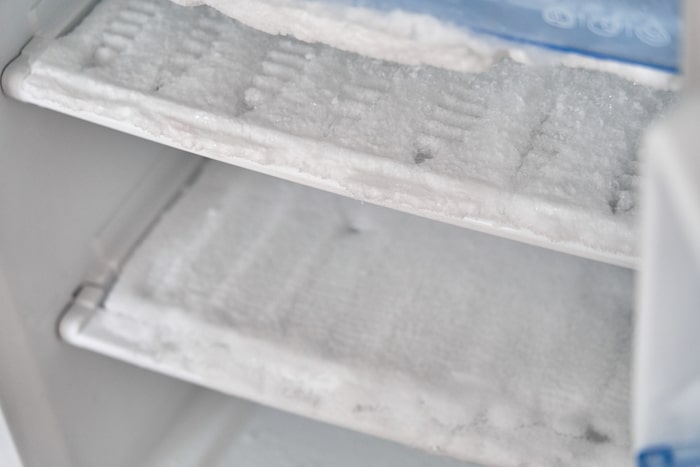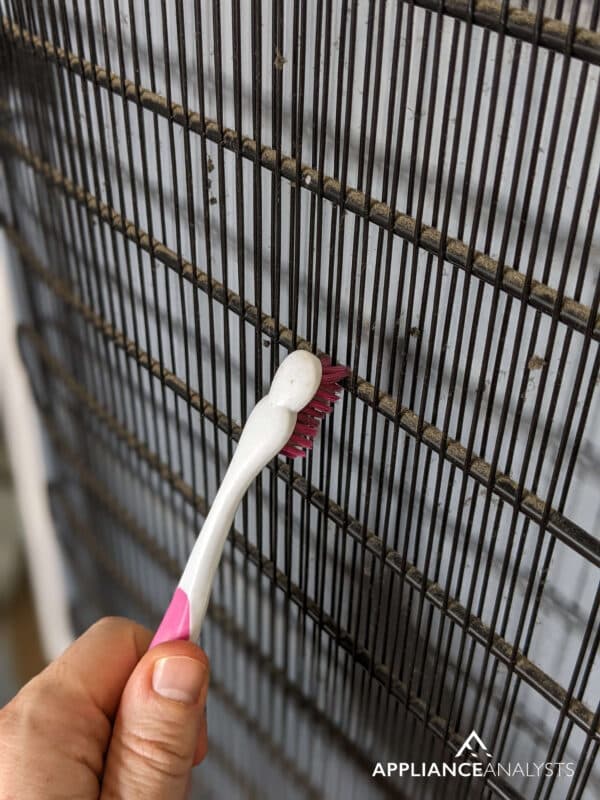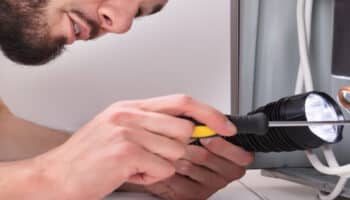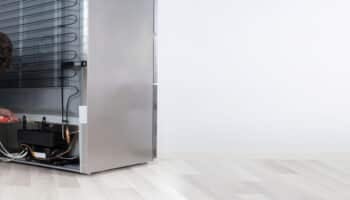We've independently reviewed this article to make sure it's as accurate as we can make it.
To find out more about our article creation and review process, check out our editorial guidelines.
Is your fridge freezing food?
I’ve been there too! Opening your refrigerator only to find frost buildup can be quite frustrating, especially when you’re trying to keep your food fresh.
Don’t worry, though. Solving the problem is very simple.
If your fridge is becoming a freezer, please defrost the unit. To prevent the issue from happening again, avoid overloading your refrigerator, check the temperature and door seal, and ensure proper airflow. Don’t forget to clean the coils, examine the damper door, test the temperature sensor, and check the compressor.
Read on to learn how to keep your fridge from freezing your food!
Why trust us? This article was written by Craig Anderson and Andy Fulenchek.
Craig has helped thousands of other homeowners repair their appliances since 2016.
Andy is one of our resident appliance repair experts with over a decade of experience. He currently runs his appliance repair company with a team of trusted technicians.
9 Simple Fixes for a Freezing Refrigerator
Unfortunately, your fridge can experience temperature issues due to numerous reasons. But don’t worry! In this section, I’ll guide you through nine solutions you can try to keep your refrigerator from freezing your food.
Are you ready? Let’s dive in!
#1 Defrost Your Fridge
Before delving into why your fridge turns into a freezer, let’s begin by defrosting the unit.
You see, ice buildup can pose an electrical hazard when inspecting your fridge’s components, especially if you’re dealing with wires. Additionally, defrosting your refrigerator will make it much easier to identify any potential issues.

Most modern refrigerators have an Auto-Defrost feature that periodically melts any accumulated ice on the evaporator coils. However, some older models still require a manual defrost.
So, if your refrigerator has frost buildup, please follow the next steps to thaw it out:
- Remove all the food containers from the fridge. I recommend transferring them to a cooler to keep them from spoiling.
- Unplug your fridge from its power source or turn it off at the circuit breaker.
- Place some towels on the floor to catch any water spills.
- Place a bowl of hot water inside your refrigerator and keep the doors open. Keep in mind that you should never use boiling water because it can damage the interior.
- If you’re in a hurry, speed up the defrosting process by using a plastic spatula to gently remove chunks of ice. Remember that you should never use sharp or metal tools.
- Some fridges and freezers have a drain hole. Please use a turkey baster and warm water to defrost it.
- Once your fridge is defrosted, allow it to dry and plug it back in.
Remember, while defrosting your fridge can offer a temporary fix for freezing issues, it’s not a permanent solution. If your refrigerator constantly over-freezes, it’s crucial to investigate and address the underlying problem. Read on to learn how to do it.
#2 Avoid Overloading Your Fridge
In my experience, one of the easiest ways to keep your fridge from becoming a freezer again is to avoid overloading it.
You see, refrigerators circulate cold air to maintain a consistent temperature throughout the interior. Unfortunately, overloading disrupts the normal airflow and can lead to some sections becoming excessively cold.
To prevent overloading your fridge, please organize your food containers and, if needed, use storage solutions, such as bins. It’s also important to regularly check your fridge’s contents. It’s easy to forget what you already have and accidentally end up buying duplicates, which can lead to overloading the appliance.
#3 Check the Temperature
I find that when a fridge becomes a freezer, it’s typically because the temperature was not set correctly.
Most refrigerators should sit between 3 °C (37.4 °F) and 5 °C (41 °F). So, if your fridge is too cold, it can start to freeze your food.
Note: Please refer to the manufacturer’s manual to find out the recommended temperature for your specific model.
The easiest way to check your refrigerator’s temperature is by placing an appliance thermometer inside the unit.

If you don’t have an appliance thermometer, you can place a glass of water on the middle shelf and away from the door. Then, wait for at least eight hours and use a regular thermometer to check the temperature.
If you need to adjust the temperature dial, remember that the higher the number, the colder your fridge will be set.
Note: After setting the correct temperature, wait for a couple of hours, and then check it with a thermometer again.
#4 Examine the Door Seal
My usual advice when fixing a fridge that is freezing the food is to examine the door seal.
The door seal (or gasket) ensures the cold air stays inside your refrigerator and warm air remains outside. Unfortunately, if the door seal is dirty, damaged, or broken, it can allow moist air to enter the unit, which can transform into ice buildup.
Since damaged door seals can lead to inconsistent temperatures and higher energy bills, it’s crucial to address the issue immediately.
First, clean the door seals with warm soapy water or vinegar. Sometimes, dirt, food debris, or grime can create gaps, which result in air leaks.
Then, please look for any signs of damage. The easiest way to do so is by placing a piece of paper or a dollar bill between the door seal and the refrigerator cabinet. Close the door and try pulling the paper out. If it slips out without resistance, the door seal is damaged and you’ll need to get a replacement.

#5 Ensure Proper Airflow
If your fridge is acting more like a freezer, you’ll need to check for airflow issues.
You see, if the cold air in your fridge isn’t distributed evenly, it can lead to cold spots and temperature changes.
So, the easiest way to ensure proper airflow is by inspecting the air vents. If food containers are blocking the vents, airflow will be restricted, resulting in excessively cold areas near the vents. Therefore, it’s crucial to keep your fridge organized, and, as mentioned above, avoid overloading it. Remember to allow some space between items.
I also recommend checking the evaporator fan, as it’s responsible for circulating cold air. As you probably imagined, if the fan is not working correctly, it can lead to airflow issues and frozen spots. So, please access the fan and try to move it manually. If it’s stuck or damaged, replace it with a new, compatible one.
Keep in mind that you’ll need to remove a protective cover or panel to access the evaporator fan. If you’re not comfortable testing or replacing the fan yourself, it’s best to call a professional.
#6 Clean the Condenser Coils
From what I’ve seen, dirty condenser coils can also explain why your fridge is freezing food.
Condenser coils are responsible for releasing the heat generated during the cooling process. Unfortunately, when the coils are covered in dust, they can’t effectively dissipate heat. As a result, your fridge needs to work harder to maintain the desired temperature, often resulting in excessive cooling.
Luckily, cleaning the condenser coils is very simple. You’ll just need to:
- Unplug your fridge from its power source and carefully move it to access the condenser coils, which are usually located at the back or across the bottom.
- Use an old toothbrush to clean the coils thoroughly.
- Vacuum the floor and wipe down the coils with a damp cloth. Then, dry them using a microfiber cloth or paper towel.
- Plug your fridge back into the power outlet.

Tip: Try cleaning the condenser coils at least once a year to prevent temperature problems and ensure your fridge’s efficiency.
#7 Examine the Damper Door
If your fridge is still acting like a freezer, then you’ll need to examine the damper door.
Single-evaporator refrigerators use one cooling system to cool both the fridge and the freezer. The system uses a damper door that is responsible for controlling the amount of cold air from the freezer that enters the fridge compartment.
While traditional refrigerators often feature manual damper doors that can be adjusted by hand, modern models come with motorized damper doors that rely on sensors.
Unfortunately, if the damper door becomes stuck in the open position, cold air will continue to flow from the freezer to the fridge. As a result, food in the fridge compartment can freeze.
Please access the damper door and look for any visible signs of damage. Keep in mind that in some fridges, the damper door is encased in Styrofoam or has adhesive that makes it stick to the wall. So, please be careful and, if needed, call a professional.
Then, look for any visible signs of damage. If the damper door is malfunctioning, you should get a replacement. Keep in mind that replacing the damper door motor can cost up to $250.
#8 Test the Temperature Sensor
Now, it’s time to check your fridge’s temperature sensor.
The temperature sensor (or thermistor) monitors the internal temperature and communicates with the control board. Then, the control board processes the signals and adjusts the cooling system to maintain the desired temperature.
If the thermistor malfunctions, it won’t accurately detect the temperature, which can lead to incorrect signals being sent to the control board. As a result, the control board can end up running the compressor or opening the damper door longer than necessary.
You can test the thermistor using a multimeter. If the resistance reading you get doesn’t match the manufacturer’s recommendations, you must replace the temperature sensor with a new one.

Please keep in mind that replacing a temperature sensor can cost around $180 (including both the part and labor).
#9 Check the Compressor
If you’ve tried all of the fixes above, but your fridge is still freezing everything, the compressor is likely faulty.
You can think of the compressor as your refrigerator’s heart. It’s responsible for compressing the refrigerant and circulating it to remove heat from the interior.
It’s normal for the compressor to cycle on and off regularly. However, if it’s running continuously for an hour or even two straight hours, it can lead to over-cooling.
When the compressor malfunctions, I usually advise considering the refrigerator’s age. If it’s over 12 years old, it’s often more cost-effective to replace the entire unit.
Wrapping Up: Keeping Your Fridge From Over-Cooling
Hopefully, now you know how to fix your refrigerator’s temperature issues.
Remember that if your fridge is becoming a freezer, you’ll need to defrost the unit. Then, check the temperature and adjust the dial if necessary. Don’t forget to check the door seals, ensure proper airflow, clean the condenser coils, examine the damper door, and test the temperature sensor.
Thank you so much for taking the time to read this guide. If you’ve found it helpful, please check out our other related posts below.
Good luck!










